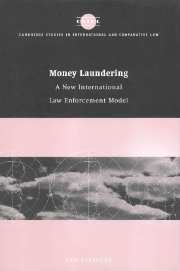Book contents
- Frontmatter
- Contents
- Preface
- Table of treaties and agreements
- List of abbreviations
- Part I New instruments in the fight against acquisitive crime: confiscation of proceeds from crime and criminalisation of money laundering
- Part II The prevention of money laundering
- 4 The application field of legislation on the prevention of money laundering
- 5 The role of financial institutions in the prevention of money laundering
- 6 The role of financial intelligence units in combating money laundering
- 7 The role of the supervisory authorities in combating money laundering
- Part III Jurisdiction over money laundering
- Part IV International co-operation in combating money laundering
- Epilogue
- Bibliography
- Index
- CAMBRIDGE STUDIES IN INTERNATIONAL AND COMPARATIVE LAW
4 - The application field of legislation on the prevention of money laundering
Published online by Cambridge University Press: 16 October 2009
- Frontmatter
- Contents
- Preface
- Table of treaties and agreements
- List of abbreviations
- Part I New instruments in the fight against acquisitive crime: confiscation of proceeds from crime and criminalisation of money laundering
- Part II The prevention of money laundering
- 4 The application field of legislation on the prevention of money laundering
- 5 The role of financial institutions in the prevention of money laundering
- 6 The role of financial intelligence units in combating money laundering
- 7 The role of the supervisory authorities in combating money laundering
- Part III Jurisdiction over money laundering
- Part IV International co-operation in combating money laundering
- Epilogue
- Bibliography
- Index
- CAMBRIDGE STUDIES IN INTERNATIONAL AND COMPARATIVE LAW
Summary
The application field of ratione personae
Other than the criminal anti-money laundering legislation that in principle applies to every citizen, the legislation on the prevention of money laundering has often a limited application field in that it applies only to specified categories of institution and professions. Whereas the criminal law focuses on money launderers (blanchisseurs), the preventive legislation is geared towards ‘money launderettes’ (blanchisseries), that is, institutions and professions that are prone to being misused for the purpose of money laundering. The distinction is by no means watertight as any ‘money launderette’ may become a money launderer – and hence be guilty of a money laundering offence – the moment it knowingly engages in a money laundering operation. In the following, the rationales for focusing on financial institutions and the arguments with respect to an expansion of the application field will be discussed.
Rationales for focusing on financial institutions
All preventive anti-money laundering measures adopted at an international level, are focused on the role of financial institutions. Thus the very first international instrument which tentatively attempted to deal with the problem, the Council of Europe Measures Against the Transfer and Safekeeping of Funds of Criminal Origin, comprised four preventive measures, three of which centred on the role of financial institutions: customer identification, limitation of the use of safes and the training of personnel. In 1988 the Committee on Banking Regulations and Supervisory Authorities, made up of the representatives of twelve supervisory authorities charged with the supervision and control of financial institutions, took it upon itself to warn financial institutions of the risks of money laundering and issued a Statement of Principles. These principles were reaffirmed in 1997 in the Basle Core Principles for Effective Banking Supervision.
- Type
- Chapter
- Information
- Money LaunderingA New International Law Enforcement Model, pp. 133 - 142Publisher: Cambridge University PressPrint publication year: 2000

